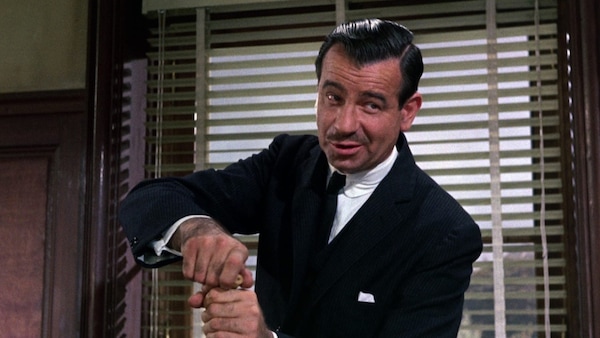Never Say Never Again: Why A Bond Remake Never Works

- Zoeb Matin
Film Companion
Last Updated: 02.24 PM, Sep 06, 2022

“Too many free radicals. That’s your problem”, declares Edward Fox’ elegantly cruel M, a far cry from the stern-faced gravitas of Mr. Bernard Lee, in this film that happens to star Sean Connery as a British agent named James Bond and follows him on an alternately dangerous and seductive mission to save the world, except that, legally speaking, this isn’t a James Bond film at all. Free radicals hardly seem to be the problem; at a prime age of 53, Connery, forever the suave Scotsman, was still able to slip effortlessly back into the tuxedo and also play along, with style, to this film’s measure of “gratuitous sex and violence”, as Q (again, no longer good old Desmond Llewellyn’s perennially frustrated gadget-maker) calls it. The rather puzzling conundrum that gave birth to Never Say Never Again (1983), an unofficial James Bond film, was this: producer Kevin McClory won a lawsuit against Ian Fleming over the story of Thunderball and was thus free, legally, to produce his own version of the story, free of the license of Messrs. Saltzman and Broccoli. This did deprive us of all the afore-mentioned people, not to forget Lois Maxwell’s evergreen Miss Moneypenny without whom both M and Bond would not be able to do anything indeed.
But the real problem with Never Say Never Again is how boring and dull it turns out to be. There were fantastic, audacious possibilities in McClory’s hand to revisit the original story of the 1960s through a more contemporary filter and there was certainly a skilled crew and some talented actors at his disposal. But all this rich potential is ruined beyond repair by director Irwin Kershner (fresh from his success with The Empire Strikes Back) and writer Lorenzo Semple, both of whom seem woefully inadequate in fleshing this lavish but ultimately pointless remake with enough enthusiasm, wit or even some genuine menace.
Take the case of Fatima Blush, the so-called femme fatale of the story. She is introduced with enough intrigue – she is always gorgeously dressed with her kohl-lined eyes and high heels and a few scenes later, as she whips and subdues a helpless Air Force pilot into her command, she is visibly dangerous and perversely alluring. Some more scenes later, however, she is visibly melting in front of her quarry Mr. Bond (who wouldn’t, indeed?) and her obvious attraction to him as well as her underestimation of his shrewd wit thwarts her every plan to dispatch him efficiently. It is indeed proven that no woman can resist the charm of this dashing secret agent but unlike Fiona Volpe, the femme fatale of Thunderball, played by the ravishing Luciana Paluzzi, who was able to arm-twist Bond considerably into submission, Blush, despite her frantic attempts, only dies out in the end most foolishly; instead of being a black widow, she merely explodes like a bug in the simmering glow of Bond’s seductive cunning.
But she too is only a minor problem and at least she is played by the unusually beautiful Barbara Carrera whose statuesque figure and Hispanic sensuality at least lends the film an attempt at mischief. The 1965 film, which was directed by Terence Young with a tight and thrilling blend of tongue-in-cheek flirtation and enough stealth and suspense, also made the most of its sultry Bahamian locations; this film, on the other hand, mere lolls around lazily in Nassau, Nice and North Africa with nothing significant to do. The domestic situation, of the villain’s sexual envy for Bond who is very capably courting his paramour, is exaggerated into a story in itself and we never, for once, feel the urgency of the danger that lies for the world. Even the odds stacked against Bond feel inconsequential; apart from Blush, there seem to be no devilish henchmen to put up with and even the action, when well-choreographed, seems to serve little purpose than just filling the plot. There is one memorably protracted fight in the corridors of a health clinic when Bond is almost outmatched by a bulking Lippe (no longer a sinister count in this film) but the explosions and stunts elsewhere lack the bite of menace and danger. Even the sharks in this version of the story are merely dumb automatons and the finale lacks the surreal underwater frenzy of the original sorely.
Does nothing else work in Never Say Never Again? Well, Connery looks as if he has only aged a year since Diamonds Are Forever; in a scene when he waltzes the insipid Kim Basinger while coolly informing her of her brother’s demise, he proves himself to be as gentlemanly as ever and he is alone responsible for one genuinely funny sight gag in a film so bereft of humour. Talking of humour, Rowan Atkinson tries to enliven things as a hilariously inept consul and the photography by Ealing legend Douglas Slocombe is pleasantly elegant and even noir-like in turns, evoking the classy spirit of the films of the 1960s. But they are all let down by the dispirited and pedestrian quality of the writing and direction, which further reminds us that perhaps Hollywood hacks should be best kept away from James Bond films.
In almost sunny, cheerful contrast, Thunderball is still a specimen of big-screen, big-budget entertainment and while it is often overshadowed by the iconoclasm of Goldfinger and the larger-than-life scale of You Only Live Twice, it is nevertheless a gorgeous, sexy and spectacular film in its own right. It also proves how a classic can never be remade perfectly.

 Premium
Premium